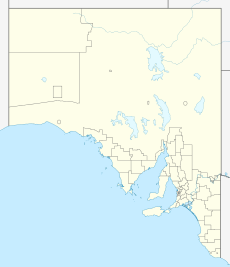Calectasia Conservation Park facts for kids
Quick facts for kids Calectasia Conservation ParkWattle Range, South Australia |
|
|---|---|
|
IUCN Category IV (Habitat/Species Management Area)
|
|
| Nearest town or city | Penola |
| Established | 7 September 1967 |
| Area | 14 hectares (35 acres) |
| Managing authorities | Department for Environment and Water |
| See also | Protected areas of South Australia |
Calectasia Conservation Park is a special protected area in South Australia. It is located in a place called Wattle Range. The park is about 320 kilometers (200 miles) southeast of Adelaide. It is also about 25 kilometers (15 miles) west of the town of Penola. This park helps protect important plants and animals.
Discover Calectasia Conservation Park
This park is found on land known as section 157 of the Hundred of Short. It sits on the southern side of the Robe - Penola Road. The park covers an area of about 14 hectares (35 acres). That's about the size of 28 football fields!
How the Park Was Created
The land first became a protected area on September 7, 1967. It was called the Calectasia National Parks Reserve then. This was done under a law called the National Parks Act 1966.
Later, on April 27, 1972, its name changed. It became the Calectasia Conservation Park. This happened when a new law, the National Parks and Wildlife Act 1972, was put in place. This new law replaced the older one.
A Special Plant: The Blue Tinsel Lily
In 1980, experts said this park was very important. It protects a plant called the blue tinsel lily. This beautiful flower is now rare in South Australia. The park also has a small swamp that fills with water in wet seasons. This swamp is important for water birds and eastern swamp rats.
What the Park Looks Like
In 1990, the park was described as having a "stranded dune system." This means it has old sand dunes that are now far from the coast. The park is split into two parts by a low-lying area. This low area makes up about 70% of the park. It often floods during the wetter months of the year.
The southern part of the park has a woodland. Here you can find brown stringybark trees. Underneath these trees, there are plants like the Austral grass tree. The low-lying area has a lot of grass, mostly from plants that were brought there.
The northern part of the park also has brown stringybark trees. You can also see large, scattered desert banksia plants. There is a thick heath undergrowth here too. The rare blue tinsel lily grows in the northeast part of the park. There's a special fence around the main group of these plants to protect them. The whole park also has a fence to keep out pests.
Protecting the Park
The park is classified as an IUCN Category IV protected area. This means it's a place managed mainly for its habitat and species. It focuses on protecting specific plants and animals.
The Calectasia Conservation Park was affected by the Ash Wednesday bushfires. These big bushfires happened in February 1983.


